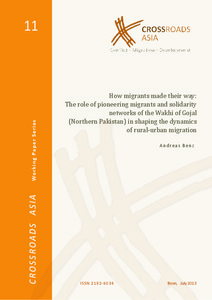How migrants made their way: The role of pioneering migrants and solidarity networks of the Wakhi of Gojal (Northern Pakistan) in shaping the dynamics of rural-urban migration

How migrants made their way: The role of pioneering migrants and solidarity networks of the Wakhi of Gojal (Northern Pakistan) in shaping the dynamics of rural-urban migration

| dc.contributor.author | Benz, Andreas | |
| dc.contributor.editor | Baldauf, Ingeborg | |
| dc.contributor.editor | Conermann, Stephan | |
| dc.contributor.editor | Kreutzmann, Hermann | |
| dc.contributor.editor | Nadjmabadi, Shahnaz | |
| dc.contributor.editor | Reetz, Dietrich | |
| dc.contributor.editor | Schetter, Conrad | |
| dc.contributor.editor | Sökefeld, Martin | |
| dc.contributor.editor | Hornidge, Anna-Katharina | |
| dc.date.accessioned | 2016-10-05T12:52:19Z | |
| dc.date.available | 2016-10-05T12:52:19Z | |
| dc.date.issued | 07.2013 | |
| dc.identifier.uri | https://hdl.handle.net/20.500.11811/134 | |
| dc.description.abstract | In this working paper, I investigate the role which solidarity networks based on different types of shared identities, perceived relatedness and kinship affiliations played for enabling, shaping, facilitating and intensifying migration processes from Gojal since the 1940s, using the example of the high mountain communities of Hussaini and Passu in lower Gojal. With the help of selected cases from these villages, I will try to show how support based on different forms of solidarity enabled new forms of migration and increasing numbers of migrants. Particular focus will be placed on the role of pioneering migrants in the early decades of out-migration from Gojal to the cities (1940s to 1970s), which mark a period of far-reaching mobility changes and decisive events for the creation of the current state of a highly mobile, translocal Gojali community. These processes eventually have led to the currently prevailing diversified migration patterns. Their characteristics and recent dynamics will be outlined in the first part of this paper. The results presented here are based on three months of fieldwork in Pakistan in autumn 2011 and 2012. A multi-local fieldwork approach was chosen (MARCUS 1995), in which communities in the sending region Gojal (Gulmit, Hussaini, Passu), as well as selected migration targets (Central Hunza, the regional centre Gilgit and the national capital Islamabad) have been visited. In these places, oral history and narrative interviews have been conducted with current and former migrants from Gojal, as well as with village elders and local experts in Gulmit, Hussaini and Passu. Particularly the narratives of 48 former military, labour and student migrants, some of them being among the earliest migrants of their villages, have helped to shed light on the early phase of migration from Gojal to Karachi. In addition, a comprehensive village census has been conducted each for the villages of Hussaini and Passu in October 2012, revealing – among other data – the migratory biographies of all household members of these villages and their close kin. | en |
| dc.format.extent | 38 | |
| dc.language.iso | eng | |
| dc.relation.ispartofseries | Crossroads Asia Working Paper Series ; 11 | |
| dc.rights | In Copyright | |
| dc.rights.uri | http://rightsstatements.org/vocab/InC/1.0/ | |
| dc.subject | Migrants | |
| dc.subject | Solidarity networks | |
| dc.subject | Eural-Urban Migration | |
| dc.subject | Northern Pakistan | |
| dc.subject | Pakistan | |
| dc.subject | Hussaini | |
| dc.subject | Passu | |
| dc.subject | Gojal | |
| dc.subject.ddc | 300 Sozialwissenschaften, Soziologie, Anthropologie | |
| dc.subject.ddc | 320 Politik | |
| dc.title | How migrants made their way: The role of pioneering migrants and solidarity networks of the Wakhi of Gojal (Northern Pakistan) in shaping the dynamics of rural-urban migration | |
| dc.type | Arbeitspapier | |
| dc.publisher.name | Competence Network Crossroads Asia: Conflict – Migration – Development | |
| dc.publisher.location | Bonn | |
| dc.rights.accessRights | openAccess | |
| dc.relation.eissn | 2192-6034 | |
| dc.relation.url | http://crossroads-asia.de/veroeffentlichungen/working-papers.html | |
| ulbbn.pubtype | Zweitveröffentlichung |
Files in this item
This item appears in the following Collection(s)
-
Crossroads Asia Working Paper Series (37)
Working Paper des Kompetenz-Netzwerks Crossroads Asia




